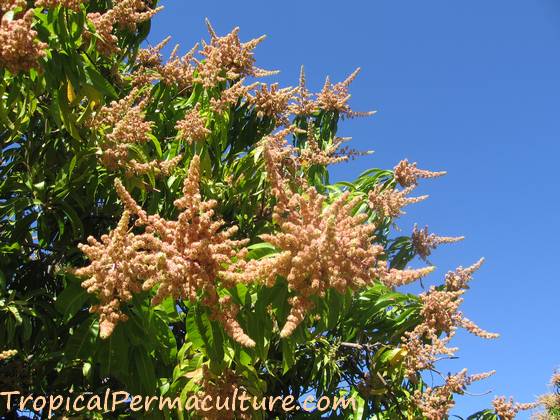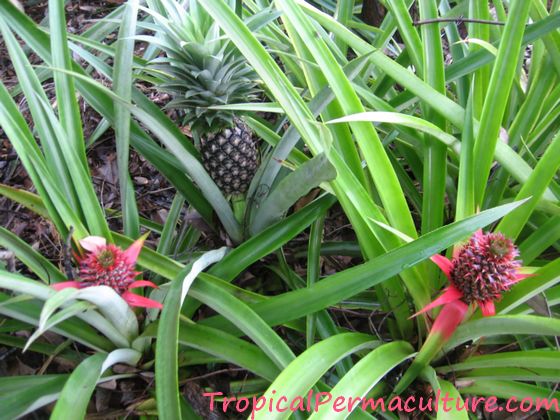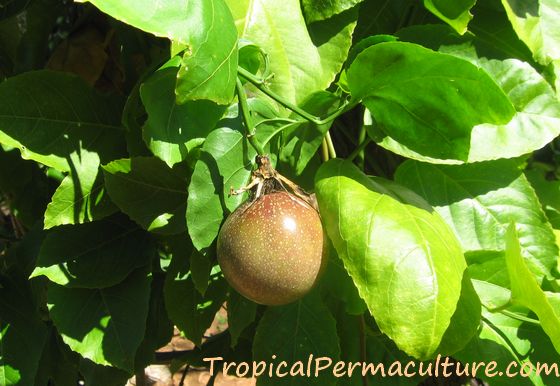Growing Papaya From Seed (Carica Papaya)
How To Grow Papaya Fruit All Year Round
I love growing papaya. They are easy to grow (once you know how to!), they are quick to fruit and they fruit all year round. I can use them both ripe or green, I can feed them to my chickens and they attract lots of wild birds into my garden.
Papayas are fast growing shade trees and they look really good, too.
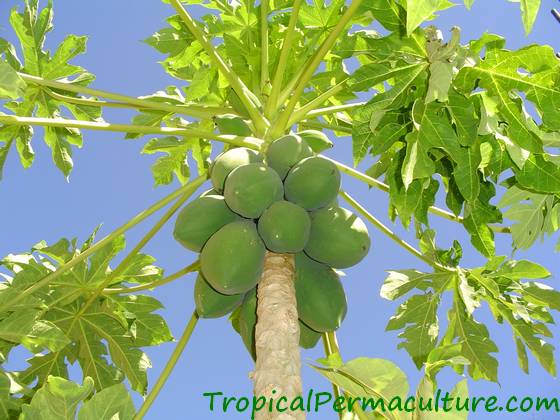
Growing papaya from seed is the easiest and most successful way to get started. Of course it's also the cheapest. You can grow papayas using seed from shop bought papayas.
However, the papaya can be a finicky plant... Papayas are easy to grow but not necessarily so easy to keep alive for long and to get good fruit from.
Below I tell you how you can easily grow papaya from seed and how you can ensure a good supply of fruit all year round.
Growing Papaya
Papaya originated in the lowland tropics of South America, but today you find papayas growing everywhere in the tropics and subtropics. It often grows wild, and every tropical food garden has several papaya trees.
To grow good papayas you need a frost free climate, lots of sunlight, lots of water and very good soil.
If you can supply all of the above you can pretty much stick some papaya seeds in the ground at any time of the year, and six to ten months later they will start fruiting.
Ok, admittedly this sounds easier than it is for most beginner gardeners. There are some hurdles and traps to watch out for when growing papayas. But if you are aware of the possible problems then there is no reason why your first attempt at growing papayas shouldn't be a smashing success. Let's look at the details...
What Do Papayas Look Like?
Here are some pictures of papayas for those of you who have never seen papaya plants.
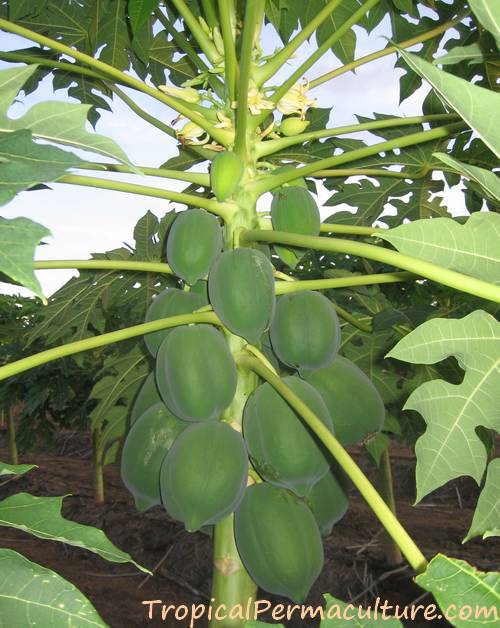
Papayas are fast growing, single stem plants. The trunk is soft and does not have a bark and papayas don't have branches.
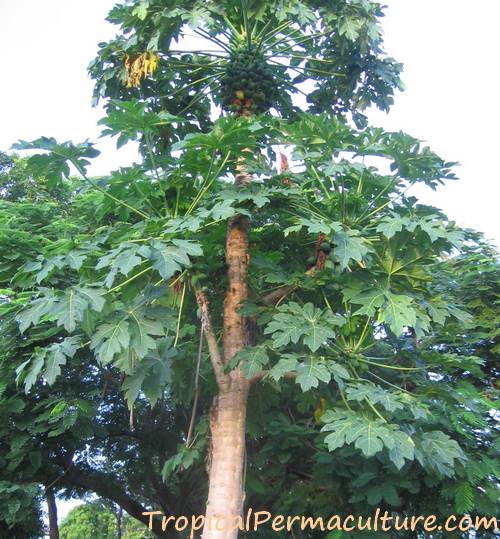 Papayas rarely grow to this age and size.
Papayas rarely grow to this age and size.
Well, usually papayas don't have branches. And they usually don't grow as old as the one in the photo above.
Anyway, the leaves are huge and don't last long. A papaya has just a tall trunk with a crown of leaves at the top of it. The overall appearance is a bit like a palm tree.
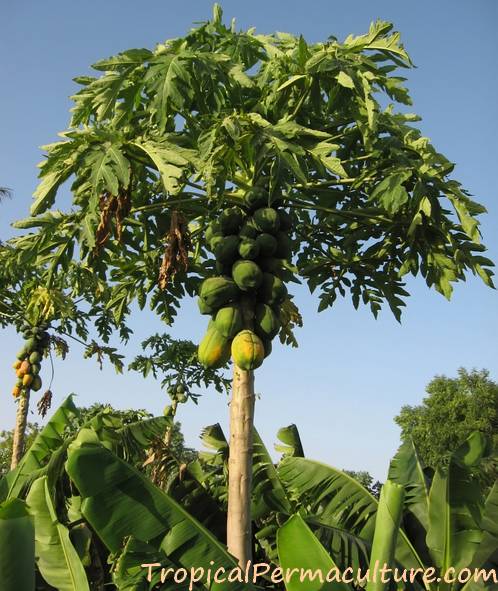
If a papaya loses the growing tip or is cut back it can develop multiple trunks.
The fruit grows on the trunk and since papayas continue to grow up and up the fruit is harder and harder to get to as the papaya plant gets older.
How To Grow Papaya From Seed
You can use any shop bought papaya for seeds, but you get the best results if you use seeds from locally grown papaya fruit.
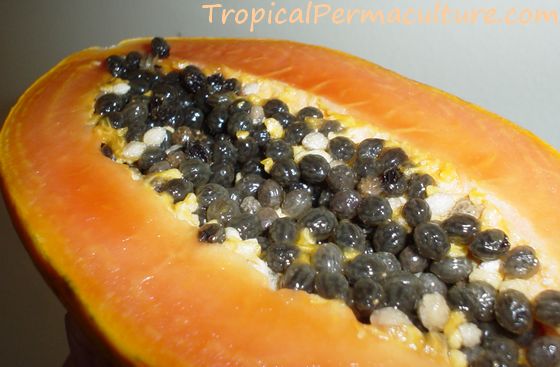
Just cut the papaya in half, scrape out the seeds, and clean and dry them. (Actually, I never bother cleaning them...)
You will end up with enough seeds to grow a papaya plantation.
Select a sunny and sheltered place in your garden. That's right, in your garden. Don't start them in pots!
Papayas don't transplant well. Anything that disturbs the roots of papayas really sets them back. They just hate it. The most fool proof way to grow papayas is to simply plant them where they are to live.
Papaya trees are very, very hungry. That means they need very good soil, rich in organic matter and nutrients.
If you don't have fabulous soil, make some. Dig a hole half a meter across and fill it with a mix of good compost and soil. Actually, make at least two or three such planting beds in different locations.
Now sprinkle on some of your seeds. A couple of dozen per bed is a good amount. I usually use even more. Cover the seeds lightly with more compost and then mulch the patch well. The seeds usually take about a couple of weeks to germinate and may take longer.
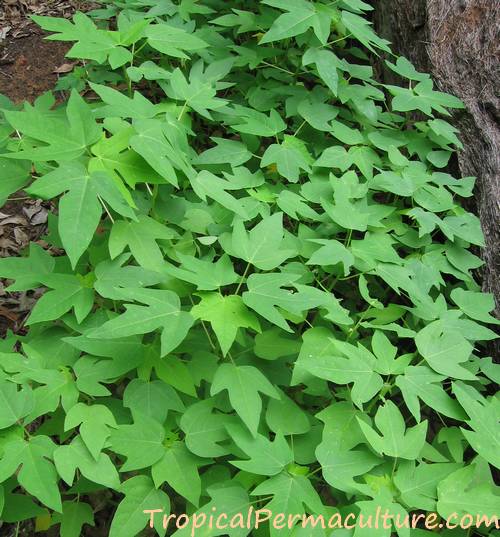
Soon you will notice that your seedlings are very different in size and vigor. That's why we planted so many. Start culling the weaker ones. Pull them out while still small or cut bigger ones down to the ground. Only keep the very best.
At this stage you should keep about half a dozen plants. Papaya plants can be male, female, or bisexual. Male papayas don't bear fruit. You want to make sure that you have some female or bisexual plants amongst your seedlings so keep enough of them.
Papayas start flowering when they are about one metre tall. The males flower first.
Male flowers have long, thin stalks with several small blooms.
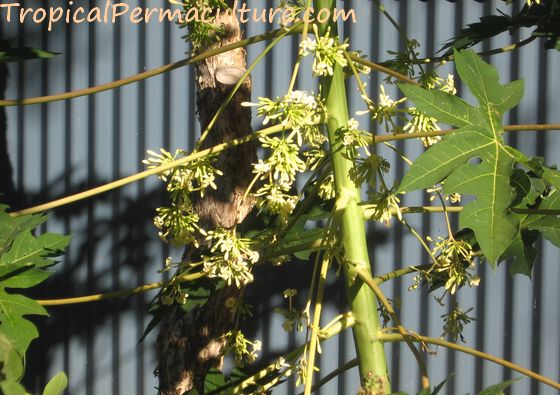
Female flowers are usually single blooms, bigger, and very close to the trunk.
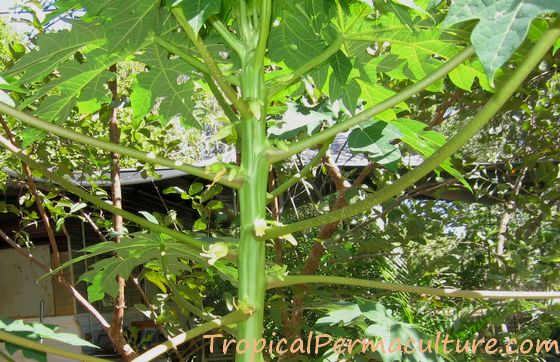
Cull most of the male plants. You only need one male for every ten to fifteen female plants to ensure good pollination.
And that's it. You should end up with one very strong and healthy female plant per bed. (And a male plant somewhere.) If the weather is warm enough, and if you are growing your papayas in full sun and in good soil, then you could be picking the first ripe fruit within 10 months.
How much water?
Papayas have large soft leaves. They evaporate a lot of water in warm weather, so they need a lot of water. But unfortunately papayas are very susceptible to root rot, especially in cool weather. Overwatering is the most common reason for problems when growing papayas.
It depends on the temperature and on the overall health and vigor of the plant. A healthier plant will cope better, but in general you should be careful not to overwater during periods of cool weather.
How much plant food?
As much as you can spare. Papayas need a lot of fertilizing. They are particularly greedy for nitrogen. Fertilize them regularly. You can use a complete fertilizer, or something like chicken manure. Papayas handle strong or fresh manures fairly well. You should also be generous with compost, and just keep piling on the mulch as the plants grow bigger.
How much sun?
As much as possible. It's ok if the leaves wilt a little bit in hot weather. Papayas love heat and sunlight. You can get them to grow in partial shade, but you just end up with a spindly, sickly tree, and if you ever get any fruit it will be several metres up in the air and taste insipid.
When do papayas fruit and how much?
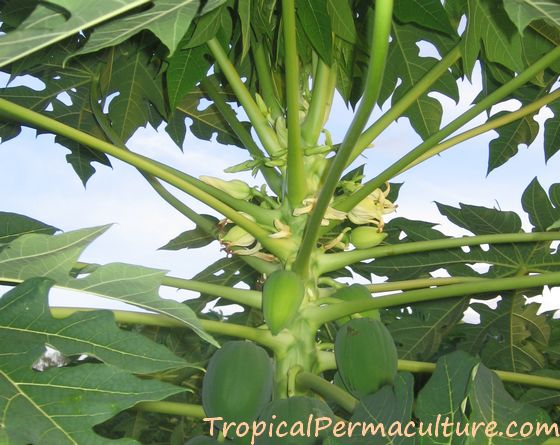
Papayas fruit all year round as long as the weather is warm enough. Keep them happy and they will keep fruiting. If the temperatures drop too much they stop flowering. They will flower again as it warms up.
Young papayas are the most productive. The older a papaya plant gets, the weaker it becomes. It will produce less and smaller fruit and it may get problems with diseases. Also, because the plants keep growing taller it gets harder to reach the fruit.
I think it's best to just keep planting more. Put in another patch every few months. That way you always have some healthy and productive plants around and you don't need a ladder to pick the fruit.
How long do papayas live?
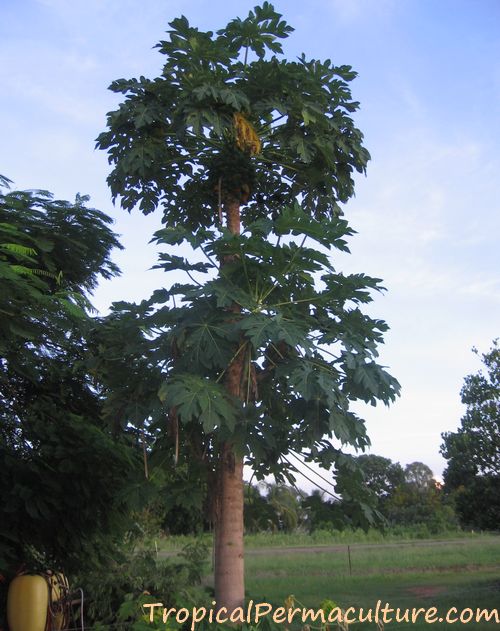
That can vary greatly, but most papaya plants are short lived. As they get older they get more susceptible to all kinds of diseases. Most of mine die some time in their second or third year. We get big storms here and usually my papayas just blow over once they get too tall.
But I also have some trees that seem indestructible. Rather than blowing over they snap off and grow multiple new trunks. I once saw a photo of a forty year old papaya!
Common Problems When Growing Papayas
I already addressed the most common problem: root rot due to overwatering. If you get cool weather keep you papaya plants dry.
If you live in an area that gets torrential tropical rains, like I do, then there is not much you can do about it. Every wet season I lose many of my mature papaya plants. It's not a problem for me, since I regularly start new plants. The young ones survive ok, and I always have some papayas fruiting somewhere.
Strong winds are another common cause of papaya disaster. Papaya plants have a very shallow root system, they get very top heavy as they grow older, and they blow over easily. Again, the solution is to replant in time.
Then there are birds, fruit bats, possums... Everybody loves papayas. The only solution here is to pick the fruit as soon as it starts to change colour. It will ripen ok on the kitchen bench.
I don't mind sharing my papaya crop anyway. I pick what I can reach and I don't worry about the fruit that's higher up. The birds can have the rest until the plant falls over and dies.
That is unless I get an exceptionally productive or nice flavoured papaya. I'm too lazy to climb ladders to pick papayas, so if a tree gets too tall I just cut it down, about two feet of the ground. Sometimes it kills them, but sometimes they grow back with several trunks. I get more fruit and it grows where I can reach it.
The best time to cut a papaya back is during dry weather. The trunk is hollow. If it fills with water it will rot. You can protect it by covering it with an upside down plastic pot or or a bag. Hot, humid weather can encourage rot.
Papayas get a whole slew of viruses and diseases, transmitted by sucking insects. Those problems are greatest during times when the plants are stressed already, for example because they have wet feet.
I don't think it's worth worrying about diseases, or trying to treat them. Just plant more.
Young, vigorous papayas are least affected by insects or diseases. Just keep planting lots of them, and always keep just the best. The planting method outlined above, and regular replanting, are the best way to ensure a regular supply of papaya.
Save your own seeds from your healthiest and tastiest plants, and over time you will breed the perfect papaya for your garden.
Growing Papaya In Cooler Climates
If you get at least long hot summers you could grow papaya just as an ornamental plant. In this case you would start them in a pot indoors to gain extra time. Plant them out against a sun facing wall and enjoy the tropical look. However, you won't be able to keep your papaya alive long enough to get fruit.
The only other option is growing papaya in a huge pot, and to keep the pot in a heated greenhouse in winter. Still, I doubt you'd get reasonable fruit of it. I would grow papaya as an annual decorative plant.
